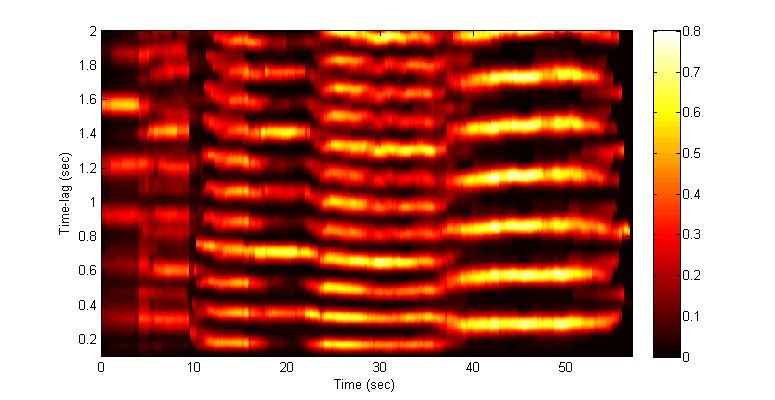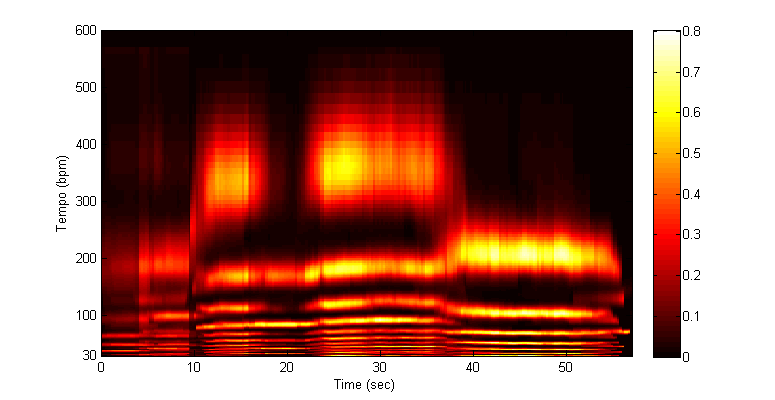Contents
%%%%%%%%%%%%%%%%%%%%%%%%%%%%%%%%%%%%%%%%%%%%%%%%%%%%%%%%%%%%%%%%%%%%%%%%%%%%%%% % Name: test_compute_tempogram_autocorrelation.m % Date of Revision: 2011-10 % Programmer: Peter Grosche % http://www.mpi-inf.mpg.de/resources/MIR/tempogramtoolbox/ % % Description: Illustrates the following steps: % 1. loads a wav file % 2. computes a novelty curve % 3. computes an autocorrelation-based tempogram % 4. visualizes the lag-axis tempogram % 5. rescales to linear tempo axis % % Audio recordings are obtained from: Saarland Music Data (SMD) % http://www.mpi-inf.mpg.de/resources/SMD/ % % % License: % This file is part of 'Tempogram Toolbox'. % % 'Tempogram Toolbox' is free software: you can redistribute it and/or modify % it under the terms of the GNU General Public License as published by % the Free Software Foundation, either version 2 of the License, or % (at your option) any later version. % % 'Tempogram Toolbox' is distributed in the hope that it will be useful, % but WITHOUT ANY WARRANTY; without even the implied warranty of % MERCHANTABILITY or FITNESS FOR A PARTICULAR PURPOSE. See the % GNU General Public License for more details. % % You should have received a copy of the GNU General Public License % along with 'Tempogram Toolbox'. If not, see % <http://www.gnu.org/licenses/>. % % Reference: % Peter Grosche and Meinard Müller % Extracting Predominant Local Pulse Information from Music Recordings % IEEE Transactions on Audio, Speech, and Language Processing, 19(6), 1688-1701, 2011. % % K. Jensen % Multiple scale music segmentation using rhythm, timbre and harmony % Eurasip Journal on Advances in Signal Processing, Vol. 2007, 2007. %%%%%%%%%%%%%%%%%%%%%%%%%%%%%%%%%%%%%%%%%%%%%%%%%%%%%%%%%%%%%%%%%%%%%%%%%%% clear close all dirWav = 'data_wav/'; filename = 'Debussy_SonataViolinPianoGMinor-02_111_20080519-SMD-ss135-189.wav';
1., load wav file, automatically converted to Fs = 22050 and mono
%%%%%%%%%%%%%%%%%%%%%%%%%%%%%%%%%%%%%%%%%%%%%%%%%%%%%%%%%%%%%%%%%%%%%%%%%%% [audio,sideinfo] = wav_to_audio('',dirWav,filename); Fs = sideinfo.wav.fs;
2., compute novelty curve
%%%%%%%%%%%%%%%%%%%%%%%%%%%%%%%%%%%%%%%%%%%%%%%%%%%%%%%%%%%%%%%%%%%%%%%%%%%
parameterNovelty = [];
[noveltyCurve,featureRate] = audio_to_noveltyCurve(audio, Fs, parameterNovelty);
3., compute autocorrelation-based tempogram
important parameters: .tempoWindow: trade-off between time- and tempo resolution try chosing a long (e.g., 12 sec) and short (e.g., 3 sec) window .maxLag/.minLag: tempo range
%%%%%%%%%%%%%%%%%%%%%%%%%%%%%%%%%%%%%%%%%%%%%%%%%%%%%%%%%%%%%%%%%%%%%%%%%%% parameterTempogram = []; parameterTempogram.featureRate = featureRate; parameterTempogram.tempoWindow = 6; % window length in sec parameterTempogram.maxLag = 2; % corresponding to 30 bpm parameterTempogram.minLag = 0.1; % corresponding to 600 bpm [tempogram, T, Lag] = noveltyCurve_to_tempogram_via_ACF(noveltyCurve,parameterTempogram);
4., visualize with time-lag axis
%%%%%%%%%%%%%%%%%%%%%%%%%%%%%%%%%%%%%%%%%%%%%%%%%%%%%%%%%%%%%%%%%%%%%%%%%%% parameterVis = []; parameterVis.yAxisLabel = 'Time-lag (sec)'; visualize_tempogram(tempogram,T,Lag,parameterVis)

5., rescale to linear tempo axis
%%%%%%%%%%%%%%%%%%%%%%%%%%%%%%%%%%%%%%%%%%%%%%%%%%%%%%%%%%%%%%%%%%%%%%%%%%%
BPM_in = 60./Lag;
BPM_out = 30:1:600;
[tempogram,BPM] = rescaleTempoAxis(tempogram,BPM_in,BPM_out);
visualize_tempogram(tempogram,T,BPM)
